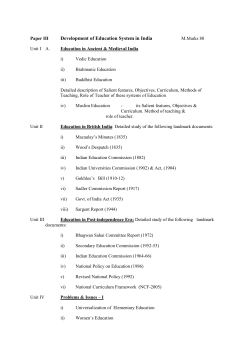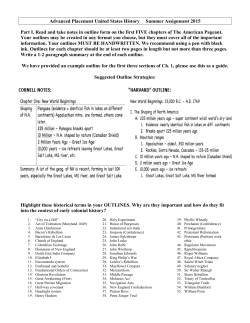
pax indica - Globestrategy
28 March 2015 Pax Indica-projecting Indian power into the Indian Ocean Suresh George India’s new aggressive posturing and projection of power in the Indian ocean This year, President Obama was the state guest at India’s Republic Day parade, just days after being forceful on both China and Pakistan, traditional rivals of India. During his visit, military cooperation, in particular the possible building of a new Indian aircraft carrier using US technology was discussed. Two weeks before, Indian military forces had staged a joint military exercise( Al Najda) with India’s closest ally in the Persian Gulf, the Sultanate of Oman. In 2014, the Indian Navy deployed two warships into the Persian Gulf to rescue citizens from Iraq. This was followed in October 2014 by the first ever Bluewater deployment of an Indian Navy fleet into East Africa. In the light of the Obama administration’s ‘Asian pivot’ strategy, the closing down of 15 US military bases in Europe and a possible US disengagement from the Middle East,, there is a case that the Indian state is augmenting its sphere of influence within the Indian Ocean. The Obama administration is very active in trying to engage with Iran, using the Sultanate of Oman as a mediator. Given that, Oman is India’s strongest ally in the Persian Gulf and both countries enjoy good © Suresh George 2015 1 28 March 2015 Anti China Axis relations with Iran, there is a strong possibility that India might play a prominent role with a fully engaged Iran. Some indication of this comes from the Indian trade in crude from Iran despite sanctions. To add to this, Indian and US mistrust of Chinese interests in both the Indian Ocean and Asia-Pacific Theatres have created new synergies. A possible US naval withdrawal from the Persian Gulf may see a power transition to the Indian Navy, which currently is the only Navy in the Asian region that possess two carrier battle group(CBG) capabilities. It therefore becomes strategic for countries both in the Persian Gulf as well as within the Indian Ocean region to engage with India’s new role as a ‘net security provide’r in the region. Why the Indian Ocean? • India’s historical linkages in the Persian Gulf (through both diaspora and trade exchanges) coupled with an increased maritime engagement with the Indian Ocean can possibly set up new spheres of Geo-strategic competition with other powers. • While providing India with both sea control and sea denial capabilities vis-a-vis Chinese and Pakistani territorial ambitions, it may test the state’s non-aligned, non-interventionist policy. • In addition to its traditional role in combating piracy, the Indian state’s proactive ‘force projection’ hard activities couple with ‘soft assets’ particularly in the Persian Gulf region can be used to augment trade with the IOR region. • India may seek to import cheap natural gas from the US as an alternative to its dependence on traditional Middle East suppliers, in return for stepping into security role. Given its geographical position in the Indian Ocean, strong historical and maritime ties to other Indian Ocean states, rebalancing of the US foreign policy paradigm and the emergence of Chinese interest in the region, there are strong indications, that India is increasing military influence in the region. Of special significance, is the fact that the Indian Navy is augmenting its Bluewater capability in the Indian Ocean region © Suresh George 2015 2 28 March 2015 to project its ability to protect the sea lanes of its trade. A number of key developments in this context are examined below. Resurgence of Nationalism Firstly ,a resurgence of nationalism, globally and particularly within India, China and Japan as a tool to spur economic growth coupled with the rise of both India and China as power rivals in Asia support the rise of India’s military influence in the Indian Ocean. India has augmented thinking on this front after the election of the nationalist BJP party. The ‘look East’ policy with a strategic engagement of Indian Ocean states specifically with states that have disputes with China is key to India’s sea control and sea denial strategy in the event of a war with China. The Navy has boosted its fleet to over 240 vessels with orders for another 40, including a new aircraft carrier. Creating a blue water navy with three battle groups, is expected to extend control over the northern Arabian Sea as well as into the Indian Ocean as part of this strategy. A series of chronological events support India’s focus on the Indian Ocean: • • • • • • • • 2002 - India signs an agreement with Mozambique for maritime patrolling off its coast 2003- The Indian navy provided seaward protection for the African Union summit at Mozambique. 2003- India signs a bilateral defence agreement with Singapore 2011- The 550 Indian Naval air Squadron is based in Male, Maldives to operate coastal patrols 2011 saw the deployment of four naval ships into the South China Sea and the Western Pacific theatre. Port calls were carried out to important allies in the Indian Ocean 2013- development of the sagar port in the Bay of Bengal as a new naval base 2013 - The building of a dedicated naval base on Karwar on the western coast of India provides the Navy unhindered access to the Indian Ocean. 2013-The second aircraft carrier, INS Vikramaditya, entered service, making India the only Navy in Asia to have two carrier battle group(CBG) capabilities. © Suresh George 2015 3 28 March 2015 • • • • • • • • Security Shifts in the Middle east 2013- India gifts a Dornier transport aircraft and a fast attack naval craft to Seychelles and Mauritius are respectively. 2014-In October the Indian Navy deploys four warships from the Western fleet into East Africa,on its first ever Bluewater deployment. 2014- Between October and November a stealth frigate of the Navy, INS Teg visits Mozambique and South Africa. 2014- In December, Indian Navy ships respond to water crisis in Maldives by providing drinking water from an Indian Navy ship. 2014- Sale of a corvette class warship to Mauritius and the activation of a coastguard listening point and radar station at Narcodam in the Andaman islands. 2014- Indian invests $100mn in the Kaladan multimodal transit transport Project using sitwe in Myanmar to link landlocked Indian regions with the Indian Ocean. Management of the national coastguard of Mauritius has for several years, been under the command of an Indian naval officer. 2015- Indian chief of naval staff visits Mauritius Middle East Security umbrella Secondly, US support to see India as a key actor in both the Indian Ocean as well as the Middle East is driving a new power dynamic amongst the coastal states. In recent times, US India ties culminating with presidential visits to India have supported a possible power transition to Indian forces in the region. A mutual distrust of Chinese actions in the Indian Ocean through the establishment of the string of pearls as well as aggressive posturing in the South China Sea supports the resurgence of India in the Indian Ocean. The willingness to cooperate in building aircraft carriers that can project Bluewater capabilities, acquisition of long-range maritime surveillance aircraft, as well as cooperation in the nuclear power sector for both civilian and military use confirm Indian- US ties. India- Iran ties are also key to the US equation with India. India has been neutral on the Iranian position vis-a-vis US attempts to engage with © Suresh George 2015 4 28 March 2015 Iran. Its energy trade with Iran has also increased over the years. Chinese ambitions in the region Thirdly, China’s opaque territorial ambitions in the Indian Ocean with a so-called ‘string of pearls’ assets has contributed to a fear within the establishment of its desire to control the sea lanes. China’s dependence on energy transits via Indian Ocean sea lanes and vulnerability in the event of a blockade is key to India’s new thinking. The strategic Chinese equation with Pakistan and the leasing of its assets to the Chinese Navy is perceived to be one reason why the Indian Navy is testing IOR capabilities. By creating Indian sea control, Pakistan would need to defend an additional thousand kilometres of its coast in the event of a conflict. As part of its Maritime silk Road Project (MSR), China investment is developing Gwadar, Sitwe and Chittagong bases as its naval assets. It is also made in inroads into Colombo , India’s immediate neighbourhood. The overwrought influence of Chinese established in Sri Lanka specifically with the last government has been a matter of great concern for India. The new government in Sri Lanka is expected to rebalance the Chinese equation in Sri Lanka, particularly if we believe reports that the Indian military establishment along with its intelligence apparatus played a key role in mobilizing support for the new president. India’s current dominance of the seas The fourth element of this analysis is India’s military involvement in the Persian Gulf state. There are reasons to believe, that the Persian Gulf states are increasingly becoming involved in the Navy’s plans, given its historical and diaspora linkages. India’s geographical location between the key choke points of the Strait of Hormuz on one side and the Straits of Malacca on the other side, necessitates in need to engage with the Persian Gulf states if the dominance of the Indian Ocean is to be achieved. The strongest indication are reports of the activation of listening post at Oman’s Ras al-Hadd . This post about 400 nautical miles from the Gwadar Port was built in 2009-2010 and significant because of its berthing facilities for both Chinese submarines and naval vessels operating in the Indian Ocean. © Suresh George 2015 5 28 March 2015 We believe that this listening post is linked to other posts (Madagascar. Kochi, Mumbai, Mauritius, Maldives, Andaman Islands) to form a string of’ Indian string of pearls’ along the Indian Ocean region. The Navy’s intelligence gathering along the Indian Ocean and Persian Gulf was augmented by the deployment in 2013 of India’s first dedicated military satellite (GSAT-7)which removed the dependence on INMARSAT. India has started to share intelligence from the satellite with Oman. New Developments Some key developments in India’s new military engagement with the Persian Gulf are: • • • • • • • • • • • • 2003- India and Iran signed the New Delhi declaration to explore opportunities to cooperate in defence. 2005- India signs a deal to develop the south pars gas field in Iran. 2006 - India and Iran start joint naval exercises. 2008, India and Qatar signs a security pact that agrees to protect its maritime and national assets from external threats. 2009-Oman received training from the Indian air force IAF contingent of Jaguars through Operation Eastern bridge 2010- The Omani army places order for the INSAS assault rifle from India 2015- India and Oman engaged in Al Najd military exercises 2013-The Indian Navy gets exclusive berthing facilities in Omani ports 2013- Secret work on fencing of the Oman and Yemen border by India’s Central public works department In February 2014, Indian and Saudi Arabia, signed the defence cooperation pact, the first ever with the Saudi state. 2014- In November, Indian Deputy Chairman of Joint Chiefs of Staff Lieutenant-General Anil Bhalla, visits Bahrain Defence Force (BDF) Commander-in-Chief Marshal Shaikh Khalifa bin Ahmed Al-Khalif and discusses military cooperation. 2015- India’s national security adviser, Ajit Doval visits Iran. Talks are carried out on developing the Chabahar port which is 44 nautical miles west of Pakistan’s Qwadar port. © Suresh George 2015 6 28 March 2015 Conclusion From this analysis, it becomes clear that India seeking a more proactive role in the IOR region to support both economic and geostrategic goals. By using its strong hard and soft assets in the Persian Gulf region, it seeks to counter territorial ambitions of other actors in the region. However, given the plural form of India’s democracy, a history of non-interventionism coupled with political challenges of building a strong military force, India’s military strategy in the Persian Gulf should be perceived as an incremental evolution. Recent delays in the commissioning of its indigenous aircraft carrier, reduction in defence expenditure and a possible slowing of its economy due to global pressures might delay this ambition. Another issue that might compound the problem, is India’s dependence on carrier battle groups instead of submarines. Given the China is concentrating on inserting submarines into the Indian Ocean and that India lacks in sheer numbers of submarines to patrol its sphere of activity, future power projection scenarios using its current strategy might prove costly. © Suresh George 2015 7
© Copyright 2025









